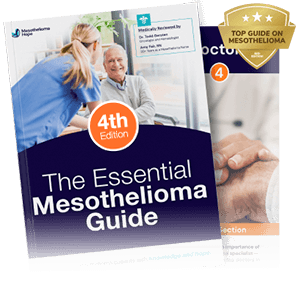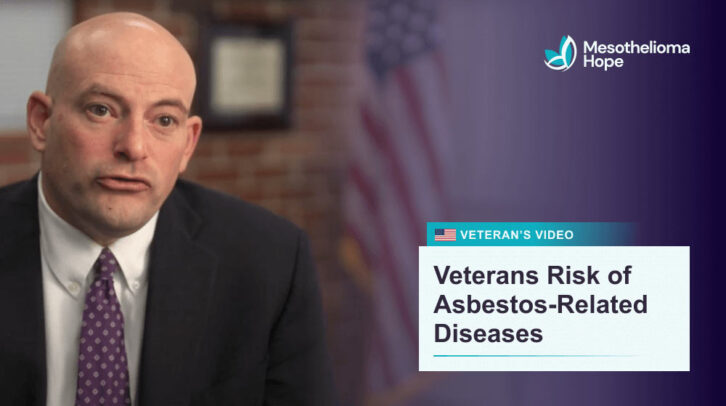Asbestos Use on Army Bases and Barracks
Asbestos was commonly used in the U.S. Army between the 1930s and early 1980s because it was cheap and abundant but also strong and fire-resistant — and people didn’t know about the health risks yet.

Asbestos exposure can be extremely dangerous because of the health conditions it can cause. Tiny asbestos fibers can be inhaled or ingested and settle in the lungs and stomach, eventually causing severe health conditions like mesothelioma.
Mesothelioma is a type of cancer that affects the mesothelium, which is the tissue that lines the lungs, chest, and abdomen. There is no cure for the condition, but treatment can reduce symptoms and increase life expectancy.
If you developed mesothelioma after being exposed to asbestos on an Army base, the team of Patient Advocates and fellow veterans at Mesothelioma Hope can help you pursue compensation and other legal assistance.
Get a free copy of our Veterans Compensation Guide now to learn what kind of help is available.
Army Bases That Contained Asbestos
Any U.S. Army barracks built on American land during the mid-1900s may have contained asbestos.
Starting in 1918 and continuing into the 1920s, asbestos was used to build family housing, barracks, and other structures on Fort Bragg, one of the nation’s largest active Army bases located in Fayetteville, North Carolina.
Even though the Army took efforts to remove asbestos from its bases in the 1980s, Fort Bragg still contains traces of the mineral today.
In March 2022, Fort Bragg was issued an OSHA violation after an inspection revealed traces of asbestos material in a three-story barracks unit.
Other examples of domestic U.S. Army bases built with asbestos include:
- Camp Dodge, Iowa
- Fort Campbell, Kentucky
- Fort Dix, New Jersey
- Fort Drum, New York
- Fort Hood, Texas
- Fort Hunter Liggett, California
- Fort Jackson, South Carolina
- Fort Leavenworth, Kansas
- Fort Knox, Kentucky
- Fort Lewis, Washington
- Fort McClellan, Alabama
- Fort McCoy, Wisconsin
- Fort Polk, Louisiana
- Hawthorne Army Depot, Nevada
- Rock Island Arsenal, Illinois
International Army Bases
Like domestic military bases, any international U.S. Army bases built prior to the 1980s may also contain asbestos.
The U.S. military has constructed army installations in foreign countries, including:
- Belgium
- Bosnia
- Bulgaria
- Cameroon
- Germany
- Israel
- Italy
- Iraq
- Japan
- Kuwait
- South Korea
Not all U.S. Army barracks and bases — on American land or elsewhere — contain asbestos. However, veterans stationed in any of these countries who think they might have developed a health condition due to asbestos exposure may qualify for financial aid to help cover treatment costs and other expenses.
Connect with our Patient Advocates now to get more information. We’re here to listen to your story and help you determine next steps.
How Did the Military Use Asbestos in Army Barracks?
Asbestos was used in each of the five major branches of the American military in a variety of ways.
A prime example is the construction of Army vehicles, specifically for parts such as gaskets and brake pads.
Asbestos was also used in construction materials and in many other elements of Army barracks and mess halls, such as:
- Caulking
- Ceiling tiles and floor tiles
- Drywall
- Electrical wiring
- Fireproofing materials
- Gaskets
- Insulation
- Piping
- Roofing
You can learn much more about asbestos exposure and the products that contained this dangerous mineral in our Free Mesothelioma Guide.
Army Personnel at Risk for Asbestos Exposure
U.S. armed forces personnel and their family members who spent time on military bases before the 1980s (or later) may have been exposed to asbestos in Army barracks. However, certain service members were at greater risk.
Asbestos fibers are dangerous when they become airborne because they can be inhaled or swallowed. Unfortunately, much of the work done on Army bases involved equipment that caused asbestos dust to be released into the air.
This made these military personnel particularly susceptible to harmful asbestos exposure:
- Aircraft mechanics
- Boilermakers
- Carpenters
- Construction workers
- Demolition workers
- Electricians
- Engineers
- Firefighters
- HVAC mechanics
- Insulators
- Maintenance workers
- Pipefitters
- Plumbers
- Roofers
If a worker got asbestos fibers on their skin or clothing while working on base, they may have unintentionally brought these harmful fibers back home to their family.
U.S. veterans who were exposed to asbestos could develop diseases like mesothelioma, asbestosis, and lung cancer decades later. Call (866) 608-8933 to get help after a diagnosis. View Transcript.
Duration: 1 min 01 sec
Veterans who served in the military between the 1930s and the 1980s were likely exposed to asbestos while they were on active duty.
Usually, if you’ve developed an asbestos-related disease, you developed that disease because you had an excessive amount of exposure to asbestos.
If a veteran believes they were exposed to asbestos while serving in the military, we encourage them to call MesotheliomaHope.com so that we can work together to help them file for VA benefits.
The VA will recognize any asbestos-related disease as long as your asbestos exposure happened while you were on active duty in the military.
In addition to VA benefits, MesotheliomaHope.com can connect veterans with world-renowned physicians and nurses on staff that can answer any of your treatment questions. We encourage veterans to call and find out how we can help them.
The U.S. stopped using asbestos products in the 1980s, but many asbestos-containing structures remained for decades to come. Some barracks still contain small amounts of asbestos today, as is the case with Fort Bragg.
That means the risk of asbestos exposure was the highest among veterans who served during these wars:
- World War II
- Korean War
- Vietnam War
- Gulf War
- War on Terror (Iraq and Afghanistan)
Many U.S. Army veterans with mesothelioma and their family members were directly exposed to asbestos in barracks, but secondhand exposure also played a role in making people sick.
VA Benefits for Veterans Exposed to Asbestos in Army Barracks
Americans brave enough to serve their country should not have to face debilitating diseases like mesothelioma on their own. Fortunately, the U.S. Department of Veterans Affairs (VA) offers veterans benefits for those who developed a service-related illness from asbestos exposure.
Veterans with mesothelioma usually receive a 100% disability rating from the VA and qualify for other benefits like pensions and medical care.
Army veterans with mesothelioma may be eligible for the following VA benefits:
- Health care: Veterans may also qualify for low-cost or free health care through the VA.
- Pensions: Army veterans with mesothelioma may be eligible for VA pensions depending on their service history and current financial need. In 2024, the base Maximum Annual Pension Rate (MAPR) is $21,674 for veterans with one dependent spouse or child.
- Special Monthly Compensation (SMC): Veterans with special health needs such as transportation and in-home care can apply for additional monthly benefits.
- VA Dependency and Indemnity Compensation (VA DIC): The surviving spouse or dependent child of a veteran who dies due to an illness they contracted while serving (such as mesothelioma) may be eligible for tax-free monthly DIC payments.
- VA Disability Compensation: Married veterans may be eligible for tax-free disability compensation totaling nearly $4,000 a month.
Additionally, U.S. Army veterans with mesothelioma can apply for financial assistance from private sources by working with a mesothelioma lawyer.
Other sources of mesothelioma compensation include:
- Asbestos trust funds: In the 1980s, the courts ordered bankrupt manufacturers to set up trust funds for people who developed health conditions from their asbestos-containing products. Over $30 billion in compensation is available in these trust funds today.
- Lawsuits: Although the value of a case depends on a number of factors, private mesothelioma lawsuits typically award veterans with an average of $1-$1.4 million in settlements. Note that these types of lawsuits are filed against the manufacturers of asbestos-containing materials — not against the U.S. government or Army.
This combination of VA-provided benefits and asbestos compensation can help Army veterans get the treatment they need and while ensuring their families are taken care of.
Our team can check whether you’re eligible for trust fund payouts — get started right now.
Get Help Filing for Veterans Benefits Today
Veterans and their family members can apply for VA benefits online, by mail, or by visiting a regional office.
It’s best to apply as soon as you’ve been diagnosed with mesothelioma so you can benefit from more affordable health care, monthly disability payouts, and — potentially — a private mesothelioma settlement.
VA benefits can help veterans with mesothelioma get the medical treatment they need while giving their families some much-needed peace of mind.
The team at Mesothelioma Hope can explain your benefit options and help you file a VA claim. Contact us right now to get started.
Asbestos in Army Barracks FAQs
Was asbestos used in military bases?
Yes. Every branch of the military — including the U.S. Army, U.S. Air Force, U.S. Coast Guard, U.S. Marine Corps, and U.S. Navy — used asbestos in bases between the 1930s and early 1980s.
In addition to the construction of barracks and bases, asbestos was used to manufacture vehicles, weapons, ships, and military assets.
Why was asbestos used in military barracks?
Although the advantages of asbestos were well known dating back to the 1930s, it would take decades for the U.S. military to find out about the drawbacks.
Companies that manufactured asbestos-containing materials were aware of the dangers, but they hid the truth to keep business booming.
In the 1980s, when the armed forces became aware of the risks, they began to remove asbestos from military bases.
Can veterans get compensation for asbestos?
Yes, veterans and their families may qualify for health benefits and financial compensation if they’ve been exposed to asbestos in Army barracks and later developed mesothelioma, asbestosis, lung cancer, or other diseases.
When a veteran files a mesothelioma lawsuit, legal action is taken against the company that made the asbestos-containing products — not against the U.S. government or armed forces.
How do you prove asbestos exposure in the military?
U.S. veterans can work with a mesothelioma lawyer to help prove that they were exposed to asbestos in Army barracks and that this exposure caused them to get sick.
Top lawyers know how to gather evidence related to when and where someone was exposed and can build strong legal claims showing asbestos exposure led to a mesothelioma diagnosis.
Is asbestos still used in the military?
Although the use of asbestos in Army barracks has stopped and the Army has taken steps to remove it from its bases, that doesn’t mean the risk has completely disappeared. Even after these efforts, there may still be a chance of exposure.
Additionally, because it can take so long for the health effects to appear, any new symptoms could be due to decades-old exposure to asbestos.








